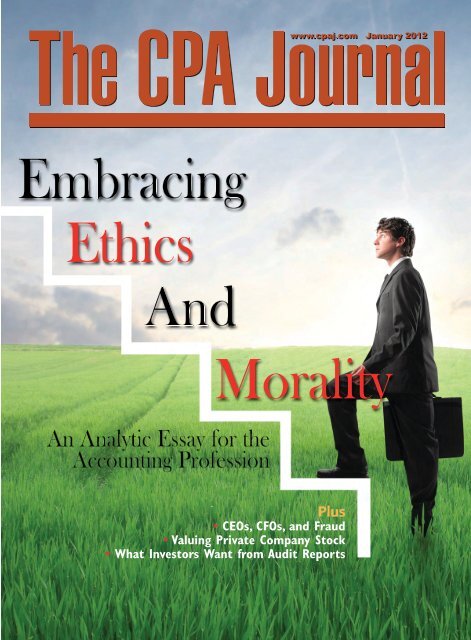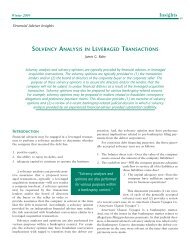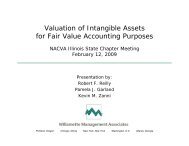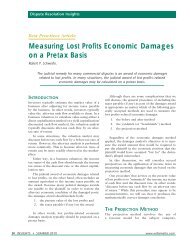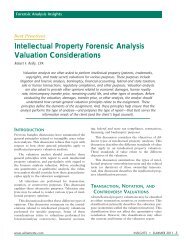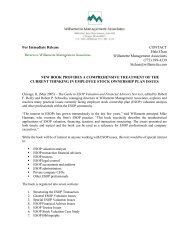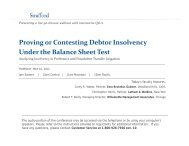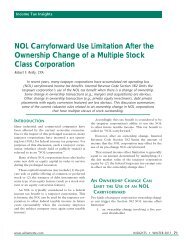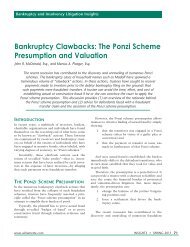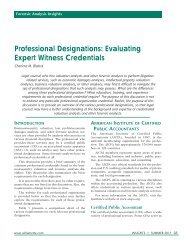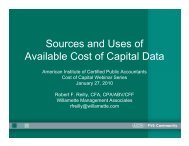View PDF - Willamette Management Associates
View PDF - Willamette Management Associates
View PDF - Willamette Management Associates
- No tags were found...
Create successful ePaper yourself
Turn your PDF publications into a flip-book with our unique Google optimized e-Paper software.
8% ÷ (1 – tax rate) = the pretax rate. Thecorresponding pretax income capitalizationrate is as follows: 8% ÷ (1 – 33%) =12%. If the analyst applies the 12% pretaxincome capitalization rate to the $120pretax income estimate, Alpha’s businessvalue would still be $1,000 (i.e., $120pretax income ÷ 12% capitalization rate).These last two calculations also answer acommon income approach question: Shoulda valuation be performed on a pretax basisor after-tax basis? As these calculations indicate,the answer is: It doesn’t matter. Aslong as the income measure and thediscount/capitalization rates are adjustedby the same income tax rate, eitherincome approach should reach the same businessvalue.Market ApproachThe market approach is based on theprinciple that a private company can bevalued by referring to pricing guidanceextracted from what investors paid inarm’s-length transactions for comparativeinvestments. The following are commonmarket approach valuation methods:■ Guideline publicly traded companymethod (GPTCM)■ Guideline merger and acquisition transactionsmethod (GMATM)■ Back-solve method.In each of these methods, analystsidentify and analyze market data regardingarm’s-length transactions. Using these data,analysts extract pricing multiples to applyto a private company. These pricing multiplesoften include the following:■ Price to revenue multiple■ Price to book value multiple■■■■■Price to EBITDA multiplePrice to EBIT multiplePrice to pretax income multiplePrice to after-tax multiplePrice to cash flow multiple.An analyst may apply more than onepricing multiple in a market approach analysis,and examine more than one time period.For example, an analyst may derivepricing multiples to apply to the privatecompany financial fundamentals for thesedifferent time periods:■ Latest (trailing) 12 months’ actualresults■■■Next 12 months’ projected resultsThree-year average actual resultsFive-year average actual results.For both the GPTCM and GMATM analyses,an analyst first attempts to identify companiesthat are directly comparable to theprivate company. Such comparable companiesare often about the same size, operatein the same industry or profession, competewith each other, have the same sources ofsupply, or have the same types of customers.Once an analyst can identify such comparablecompanies, the market approach analysisis relatively easy.Of course, an analyst will have to adjustthe financial statements of both the comparablepublic companies and the private companyfor non-operating items, non-recurringitems, differences in accounting principles,and other so-called normalization adjustments.An analyst can often apply thederived mean or median pricing multiples tothe private company’s financial fundamentals.Analysts will typically synthesize (orweight) the various value indications into onemarket approach estimate.It is rare, however, for a valuation analystto identify comparable public companiesfor most private companies. Comparedto most publicly traded or recently acquiredcompanies, the typical private company ismuch smaller, operates regionally, andoperates in a specialized segment of anindustry; therefore, valuation analystsgenerally select and rely on guideline companies.Guideline companies are similarto the private company from an investmentrisk and expected investment return perspective.Guideline companies fit into thesame investment portfolio of companies asprivate companies; that is, investors wouldexpect the same rate and variability ofreturns for all of these companies. Butguideline companies do not necessarily“look like” the subject company.Guideline public company pricing multiplesare more difficult for a valuation analystto apply. It is not reasonable to assumethat mean or median pricing multipleswould automatically apply to the privatecompany, because the selected companiesare not directly comparable. Nevertheless,an analyst can compare a private companyto guideline companies in terms offactors such as relative growth rates, relativeprofit margins, and relative returns oninvestment. From these comparative analyses,an analyst can extract pricing multiplesto apply to the private company’sfinancial fundamentals.The GPTCM is based on an analyst’sconsiderations of guideline public companiesthat trade on national and regionalstock exchanges. Those trading prices andpricing multiples are typically based on relativelysmall trades (i.e., a few thousandshares per trade) of very liquid securities.The GMATM is based on an analyst’sassessment of recent mergers and acquisitionsof entire companies in the privatecompany’s industry. These transactionalprices and pricing multiples are typicallybased on what a strategic buyer is willingto pay to obtain operational control of anoverall business enterprise.The back-solve method looks at historicalsales of stock in the subject company; inother words, an analyst investigates actualarm’s-length sales of company stock anddevelops pricing multiples from thosetransactions. Such transactions typically representsales of small blocks of stock in veryilliquid (private company) securities. Basedon the pricing multiples indicated by recentsale transactions, the analyst “back-solves”the value of the company overall businessusing the techniques described above.As indicated above, different marketapproach valuation methods could all reachdifferent levels of value. The related adjustmentsare summarized in “Levels ofValue” below.Asset ApproachThe asset approach (also called theasset-based approach) is founded on theprinciple that a private company’s equityvalue is equal to the value of the closelyheld corporation’s assets, less the value ofthe closely held corporation’s liabilities. Theasset approach is used less frequently thanthe income approach or the market approachin the valuation of closely held corporationsecurities for the following reasons:■ It is more time consuming and, therefore,more expensive to perform.■ Many valuation analysts do not havethe experience or expertise required tovalue individual assets and liabilities.■ Many valuation analysts are simplyuninformed or misinformed regarding theapplication of this valuation approach.The asset approach is, however,particularly applicable in the following circumstances:■ The company is either capital assetintensive or intangible asset intensive.48JANUARY 2012 / THE CPA JOURNAL
■ The company is either relatively newor has experienced a recent period of negativeoperating results.■ A buyer or stock acquisition financingsource wants to know the debt collateralvalue of the company assets.■ A buyer or financing source wants toknow the post-financing solvency of thecompany.■ A third party wants to know what thepost-transaction company fair value balancesheet will look like if the stock purchaseresults in a change of control.■ A buyer wants to know why it is beingasked to pay a multiple of earnings or amultiple of book value for the private company;in other words, what operating assetsare the investors buying in the stock purchasetransaction?In order to perform an asset approachvaluation, an analyst has to identify andvalue the following categories of assets andliabilities:■ Net working capital (e.g., accountsreceivable and inventory)■ Tangible personal property (e.g.,machinery and equipment)■ Real estate (e.g., land and buildings)■ Identifiable intangible assets (e.g.,patents, copyrights, trademarks, licensesand permits, computer software, customerrelationships)■■■Intangible value in the form of goodwillContingent liabilitiesRecorded liabilities.The following are some caveats to correctthe misconceptions that many valuationanalysts—and many CPAs—holdabout the asset approach:■ It does not conclude a liquidation valuein the company; rather, all of the tangible andintangible assets are valued on a continueduse/going concern basis, so the concludedbusiness value is a going concern value.■ It does not consider tangible assets only;rather, in most successful companies, mostof the business value relates to identifiedintangible asset value and to goodwill.■ It does not rely on speculative valuesfor intangible assets; rather, these valuesare exactly the same as those that wouldbe recorded on audited GAAP financialstatements as the result of a purchase priceallocation.■ It does not result in the net book valueconclusion as reported in the company’s balancesheet; rather, a pre–fair value balancesheet and a post–fair value balance bear littlerelationship to each other.■ The most common asset approachvaluation methods include the asset accumulationmethod and the adjusted net assetvalue method.The typical asset approach valuation formulais summarized as follows:working capital value+ tangible assets value+ intangible assets value= total assets value– recorded liabilities value– contingent liabilities value= private company equity valueIn addition to valuing a company’sintangible assets, an analyst also has to identifyand quantify any off–balance sheetcontingent liabilities. Such liabilitiesinclude lawsuits, environmental concerns,and similar items.Typically, the asset approach will indicatea company’s total equity value on a marketable,controlling interest level of value.At this stage of a private stock valuation,an analyst will typically adjust all ofthe indicators to be on the same level ofvalue. Then, the analyst will synthesize(i.e., weight) the income, market, and (ifperformed) asset approach value indicatorsin order to reach one final value conclusionfor the private company. This weightingis based on the analyst’s assessment ofthe quantity and quality of available data,the applicability of each approach to thecompany, and the range and reasonablenessof the various value indicators.To simplify the discussion, assume thatan analyst has concluded the company’stotal equity value. In practice, there istypically an intermediate procedure inwhich the analyst first concludes thecompany’s invested capital value. Fromthis invested capital, the analyst subtractsthe company’s long-term interest bearingdebt, to reach the total equity value. Fromthis total equity value amount, the analystsubtracts the value of any company preferredstock to conclude a preliminary commonequity value. The analyst adjusts thetotal common equity value for the proceedsfrom any in-the-money stock options.The analyst then concludes the final totalequity value (and the number of outstandingcompany shares, including exercisedin-the-money options). This procedure istypically called a waterfall analysis.Levels of ValueThe term “level of value” refers to twoinvestment criteria regarding private companystock:■ Marketable versus nonmarketable—thiscriterion indicates how easy it is for theshareholder to sell stock and convert thatinvestment into cash.■ Control versus lack of control—this criterionindicates how much control theshareholder has over the company’s businessoperations and strategic direction.Many valuation analysts (and manyCPAs) believe that there are only three separateand independent levels of value:■ Marketable, controlling ownershipinterest (e.g., one shareholder owns 100%of the closely held corporation)■ Marketable, noncontrolling ownershipinterest (e.g., as if the closely held corporationstock was publicly traded on a stockexchange)■ Nonmarketable, noncontrolling ownershipinterest (e.g., stockholder shareholderowns a small block of stock in the closelyheld corporation)In truth, the above-listed levels of valuerepresent a gross oversimplification. For allcompanies, these two investment criteriaeach exist on a continuum. Exhibit 1 moreaccurately reflects the level of value considerationsthat an investment analyst shouldassess with regard to company stock:Where the subject block of stock falls inthis X axis and Y axis continuum is a functionof the following factors:■ The absolute size of the block ofstock■ The relative size of the block of stock(compared to other stockholders)■ The relative voting rights and policiesof the private company■ The state in which the private companyis incorporated■ The absolute number of directors on theboard and the rotation of board elections■ The potential for a corporate liquidityevent (e.g., an initial public offering,stock tender offer)■ The ability of a plan participant to putshares back into the company■ The contractual rights of the block ofstock (e.g., come-along rights, tag-alongrights, rights of first refusal, registrationrights)■ The history of private transactions inthe company stockJANUARY 2012 / THE CPA JOURNAL 49
or supplier, an intellectual property licensoror licensee■ A company repurchase of its own stockfrom a non-ESOP party■ The sale or other transfer of stock thatdoes not involve either the ESOP or thecompany; for example, non-ESOP shareholdergift, estate, charitable contribution,or marital estate transfers■ Other contractual agreements betweenthe company and special employeesthat do not include stock transfers; forexample, employment, noncompete, consultancy,board membership, intellectualproperty license, and other agreements.In these above-listed scenarios, a valuationanalyst will likely have one set of valuationconsiderations for transactionsinvolving an ESOP and a slightly differentset of valuation considerations for transactionsinvolving a non-ESOP party. Forpurposes of this discussion, the term“special employees” will be consideredsynonymous with the term “key employees.”These are employees that the companywants to retain and are difficult toreplace. In addition to senior management,this category could include skilled engineers,scientists, salesmen, production specialists,or quality specialists. What makesthis class of employees special is that managementmay grant these employeesoptions, warrants, or rights with regard tothe company stock.As CPAs are aware, ERISA providesthat an ESOP may acquire employerstock “if such acquisition, sale or lease isfor adequate consideration.” With regardto pricing closely held corporation stock,ERISA defines adequate consideration asthe “fair market value of the asset determinedin good faith by the trustee or namedfiduciary.”These ERISA definitions mean that anESOP may pay no more than a fair marketvalue price for private stock. An ESOPcan, however, pay less than fair marketvalue, if for example the trustee negotiatesa favorable deal with the company orselling stockholders. Sellers may often unilaterallyoffer a below-market price to theESOP as a form of gratitude to companyemployees or as a reward for years of loyalservice. This is simply one explanationfor why an ESOP may pay a different (inthis case, lower) price for the stock thanother shareholders.There are also situations where a privatecompany or selling shareholders may sellstock to non-ESOP shareholders for a belowmarketprice. Such a situation often occurswhen a company wants to attract, retain, orreward special employees. In a leveragedstock purchase transaction, the financing termsshould be at least as favorable to an ESOPas they are to other deal participants. Justbecause a private company allows specialemployees to purchase stock at a favorableprice, however, does not mean that the saletransaction is unfair to the ESOP.Factors that Affect ValuationConsiderationsThere are a variety of reasons why aCPA might apply different considerationsJANUARY 2012 / THE CPA JOURNAL 53
indenture, or other contract. In contrast, anESOP generally expects to be able to (atleast) influence when a closely held companyhas an IPO or a merger and acquision(M&A) transaction occurs.Tenth, there may be a difference in theinformation disclosure rights available toan ESOP compared to a non-ESOPinvestor. The ESOP trustee receives thecompany stock independent valuationreport each year. That stock valuationincludes: historical and current companyfinancial statements; a current company,industry, and strategic analysis; and projectionsof future results of operations. TheESOP trustee receives a fair amount ofcompany financial and operational information.Most closely held companies arenot very forthcoming with such company-specificinformation. In contrast, unlessthey have specific contractual rights, non-ESOP stockholders do not have access tothe same information. Even specialemployees (other than a CEO and CFO)may not have as much access to company-specificinformation as the ESOP trusteedoes. A company’s financing sourcesmight have contractual access to the financialstatements, but they might not haveaccess to the stock valuation reports.Eleventh, ESOP stockholders and non-ESOP stockholders enjoy different levelsof shareholder protection. The ESOP andthe plan participants are protected byERISA. The annual stock valuation mustcomply with ERISA, and is subject to contrarianreview by the IRS and the U.S.Department of Labor. In contrast, a non-ESOP stockholder is not subject to ERISAprotection, but rather only applicable statesecurities statutes. A non-ESOP stockholderhas no assurance that it can purchasethe stock for no more than fair marketvalue and sell the stock for no less thanfair market value. A non-ESOP stockholdermay only be able to negotiate the best priceit can to buy or sell the stock, which mightbe higher or lower than fair market value.Finally, the most significant differencebetween an ESOP and non-ESOP stockholdermay be the level of value issue. Asdescribed above, level of value relates tothe following two investment criteria:■ Marketable versus nonmarketable interests■ Controlling versus noncontrolling interests.Stock owned by an ESOP may representa different level of value than stockowned by a non-ESOP investor. In fact,this is often the case, because two differentshareholders cannot both own a controllinginterest in a company. If the ESOPowns a controlling interest, then the non-ESOP does not, and vice versa.In addition, many ESOPs have contractualrights that allow the plan to acquireownership control over a period of time.For example, the contract may allow anESOP to continue to buy blocks of stockeach year until it either owns control of thecompany or owns 100% of the company.In such a case, an ESOP is often treatedas a controlling owner—and the employerstock purchase/sale transaction is oftentreated as a control-level transaction—forstock valuation purposes.In addition, as described above, there arenumerous factors (contractual, regulatory,and otherwise) that affect the marketabilityof ESOP-owned stock compared to non-ESOP owned stock. A valuation analystwill consider all of these factors whenassessing where each block of companystock falls on the marketability continuum.Paying Attention to the DifferencesCPAs understand that different fair marketvalue estimates may be appropriatefor different blocks of private companystock. Likewise, there may be differentvalue estimates depending upon whetherthe same block of stock is owned by anESOP or a non-ESOP investor.There are generally accepted valuationapproaches and methods related to the valuationof a closely held company. Andthere are generally accepted considerationsrelated to the valuation of ESOP-ownedand non–ESOP owned stock in a closelyheld company. These considerations aredifferent because:■ An ESOP and a non-ESOP stockholderhave different investment objectivesand different investment time horizons.■ ESOP and non-ESOP–owned securitiesmay enjoy different rights and privileges(including ERISA-related rights).■ An ESOP and a non-ESOP stockholdermay own company stock at two differentlevels of value.■ ESOP and non-ESOP–owned stockmay be paid for from two fundamentallydifferent levels of company cash flow—employer contributions that reduce thecompany’s income and value versus profitdistributions that do not reduce thecompany’s income and value.This last difference is particularlyimportant for S corporations. There is usuallylittle income tax advantage for S corporationsto make plan contributions, asopposed to shareholder profit distributions.Nevertheless, the stock valuation impact ofthis decision can be material. If an ESOPstock acquisition loan is repaid from companycontributions, then all company shareholdersshare in the cost of the ESOPstock purchase. In contrast, if an ESOP stockacquisition loan is repaid from companyprofit distributions, then only the ESOP paysfor the cost of the ESOP stock purchase.In this situation, non-ESOP stockholders donot subsidize the cost of the ESOP stockpurchase through reduced (after plan contributionexpense) company profits andreduced (due to lower profits) companystock values.There are also several specific differencesbetween ESOP-owned stock andnon–ESOP owned stock. Many of thosedifferences are summarized above. A valuationanalyst should consider each of themin the analysis of the private stock to anESOP versus another party.There are many different scenarios wherea private company might sell or otherwisetransfer stock to an ESOP at a differentprice than to a non-ESOP investor. In manyof these scenarios, a private company (orthe selling shareholders) will sell stock to anESOP, which will serve as a long-term ownerof the company’s permanent capital base. Incontrast, a private company might sell stockto other parties for different reasons, such asto attract, retain, or compensate keyemployees, suppliers, joint ventures, orfinancing sources. The relationship betweenthese parties and a closely held company isfundamentally different than the relationshipbetween an ESOP and the company. And theinvestment criteria of these parties may befundamentally different than an ESOP’sinvestment criteria. A CPA should considerthese differences when analyzing the fair marketvalue of the stock to an ESOP, comparedto the investment value of the stock to anon–ESOP stockholder.❑Robert F. Reilly is managing director of<strong>Willamette</strong> <strong>Management</strong> <strong>Associates</strong>(www.willamette.com), Chicago, Ill.JANUARY 2012 / THE CPA JOURNAL55


